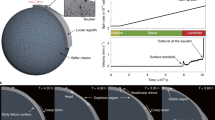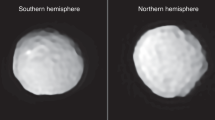Abstract
The top-shaped morphology characteristic of asteroid (101955) Bennu, often found among fast-spinning asteroids and binary asteroid primaries, may have contributed substantially to binary asteroid formation. Yet a detailed geophysical analysis of this morphology for a fast-spinning asteroid has not been possible prior to the Origins, Spectral Interpretation, Resource Identification, and Security-Regolith Explorer (OSIRIS-REx) mission. Combining the measured Bennu mass and shape obtained during the Preliminary Survey phase of the OSIRIS-REx mission, we find a notable transition in Bennu’s surface slopes within its rotational Roche lobe, defined as the region where material is energetically trapped to the surface. As the intersection of the rotational Roche lobe with Bennu’s surface has been most recently migrating towards its equator (given Bennu’s increasing spin rate), we infer that Bennu’s surface slopes have been changing across its surface within the last million years. We also find evidence for substantial density heterogeneity within this body, suggesting that its interior is a mixture of voids and boulders. The presence of such heterogeneity and Bennu’s top shape are consistent with spin-induced failure at some point in its past, although the manner of its failure cannot yet be determined. Future measurements by the OSIRIS-REx spacecraft will provide insight into and may resolve questions regarding the formation and evolution of Bennu’s top-shape morphology and its link to the formation of binary asteroids.
This is a preview of subscription content, access via your institution
Access options
Access Nature and 54 other Nature Portfolio journals
Get Nature+, our best-value online-access subscription
$29.99 / 30 days
cancel any time
Subscribe to this journal
Receive 12 digital issues and online access to articles
$119.00 per year
only $9.92 per issue
Buy this article
- Purchase on Springer Link
- Instant access to full article PDF
Prices may be subject to local taxes which are calculated during checkout





Similar content being viewed by others
Code availability
ANSYS Mechanical APDL is commercially available (https://www.ansys.com/services/training-center/structures/introduction-to-ansys-mechanical-apdl).
Data availability
The data that support the plots within this paper and other findings of this study are available from the corresponding author upon reasonable request. Spacecraft tracking data and ancillary files will be available via the Planetary Data System (PDS) (https://sbn.psi.edu/pds/resource/orex/). Data are delivered to the PDS according to the OSIRIS-REx Data Management Plan available in the OSIRIS-REx PDS archive. Higher-level products, for example, slope maps, will be available in the PDS one year after departure from the asteroid.
References
McMahon, J. W. et al. The OSIRIS-REx radio science experiment at Bennu. Space Sci. Rev. 214, 43 (2018).
Williams, B. et al. OSIRIS-REx flight dynamics and navigation design. Space Sci. Rev. 214, 69 (2018).
Barnouin, O. S. et al. Shape of (101955) Bennu indicative of a rubble pile with internal stiffness. Nat. Geosci. https://doi.org/10.1038/s41561-019-0330-x (2019).
Watanabe, S. et al. Hayabusa2 arrives at the carbonaceous asteroid 162173 Ryugu — a spinning-top-shaped rubble pile. Science https://doi.org/10.1126/science.aav8032 (in the press).
Chesley, S. R. et al. Orbit and bulk density of the OSIRIS-REx target asteroid (101955) Bennu. Icarus 235, 5–22 (2014).
Rozitis, B. & Green, S. The influence of rough surface thermal-infrared beaming on the Yarkovsky and YORP effects. Mon. Not. R. Astron. Soc. 423, 367–388 (2012).
DellaGiustina, D. N. et al. Properties of rubble-pile asteroid (101955) Bennu from OSIRIS-REx imaging and thermal analysis. Nat. Astron. https://doi.org/10.1038/s41550-019-0731-1 (2019).
Scheeres, D. J. et al. The geophysical environment of Bennu. Icarus 276, 116–140 (2016).
Murdoch, N., Sanchez, P., Schwartz, S. R. & Miyamoto, H. in Asteroids IV (eds Michel, P., DeMeo, F. E. & Bottke, W. F.) 767–792 (Univ. of Arizona Press, Tucson, 2015).
Scheeres, D. J., Hartzell, C. M., Sánchez, P. & Swift, M. Scaling forces to asteroid surfaces: the role of cohesion. Icarus 210, 968–984 (2010).
Walsh, K. J. et al. The dynamic surface geology of asteroid (101955) Bennu. Nat. Geosci. https://doi.org/10.1038/s41561-019-0326-6 (2019).
Van wal, S. & Scheeres, D. J. The lift-off velocity on the surface of an arbitrary body. Celest. Mech. Dynam. Astron. 125, 1–31 (2016).
Rieger, S. M., Scheeres, D. J. & Barbee, B. Orbital stability regions for hypothetical natural satellites of (101955) Bennu. J. Spacecraft Rockets https://doi.org/10.2514/1.A34160 (2018).
Nolan, M. C. et al. Detection of rotational acceleration of Bennu using HST light curve observations. Geophys. Res. Lett. https://doi.org/10.1029/2018GL080658 (2019).
Hergenrother, C. W. et al. Operational environment and rotational acceleration of asteroid (101955) Bennu from OSIRIS-REx observations. Nat. Commun. https://doi.org/10.1038/s41467-019-09213-x (2019).
Pravec, P. et al. Binary asteroid population. 3. Secondary rotations and elongations. Icarus 267, 267–295 (2016).
Walsh, K. J., Richardson, D. C. & Michel, P. Spin-up of rubble-pile asteroids: disruption, satellite formation, and equilibrium shapes. Icarus 220, 514–529 (2012).
Tardivel, S., Sánchez, P. & Scheeres, D. J. Equatorial cavities on asteroids, an evidence of fission events. Icarus 304, 192–208 (2018).
Scheeres, D. J. Landslides and mass shedding on spinning spheroidal asteroids. Icarus 247, 1–17 (2015).
Sánchez, D. P. & Scheeres, D. J. The role of angular momentum on accreting rubble pile shapes. In 49th Lunar Planet. Sci. Conf. abstr. 1196 (Lunar and Planetary Institute, 2018).
Michel, P. et al. Disruption and reaccumulation as the origin of the Ryugu and Bennu top Shapes? In AGU Fall Meeting 2018 abstr. P33C-P33850 (AGU, 2018).
Statler, T. S. Extreme sensitivity of the YORP effect to small-scale topography. Icarus 202, 502–513 (2009).
Bottke, W. F. et al. In search of the source of asteroid (101955) Bennu: applications of the stochastic YORP model. Icarus 247, 191–217 (2015).
Golubov, O. & Scheeres, D. J. Systematic structure and sinks in the YORP effect. Astrophys. J. 157, 105 (2019).
Hirabayashi, M. & Scheeres, D. J. Stress and failure analysis of rapidly rotating asteroid (29075) 1950 DA. Astrophys. J. Lett. 798, L8 (2015).
Minton, D. A. The topographic limits of gravitationally bound, rotating sand piles. Icarus 195, 698–704 (2008).
Harris, A. W., Fahnestock, E. G. & Pravec, P. On the shapes and spins of ‘rubble pile’ asteroids. Icarus 199, 310–318 (2009).
Hirabayashi, M., Sánchez, P. & Scheeres, D. J. Internal structure of asteroids having surface shedding due to rotational instability. Astrophys. J. 808, 63 (2015).
Hirabayashi, M. & Scheeres, D. J. Rotationally induced failure of irregularly shaped asteroids. Icarus 317, 354–364 (2019).
Sánchez, P. & Scheeres, D. J. Rotational evolution of self-gravitating aggregates with cores of variable strength. Planet. Space Sci. 157, 39–47 (2018).
Scheeres, D. J. et al. Dynamical configuration of binary near-earth asteroid (66391) 1999 KW4. Science 314, 1280–1283 (2006).
Jacobson, S. A. & Scheeres, D. J. Dynamics of rotationally fissioned asteroids: source of observed small asteroid systems. Icarus 214, 161–178 (2011).
Lauretta, D. S. et al. The unexpected surface of asteroid (101955) Bennu. Nature https://doi.org/10.1038/s41586-019-1033-6 (2019).
Rizk, B. et al. OCAMS: The OSIRIS-REx Camera Suite. Space Sci. Rev. 214, 26 (2018).
Pelgrift, J. Y. et al. In-flight calibration of the OSIRIS-REx optical navigation imagers. In 1st Annual RPI Workshop on Image-Based Modeling and Navigation for Space Applications (RPI, 2018).
Evans, S. et al. MONTE: the next generation of mission design and navigation software. CEAS Space J. 10, 79–86 (2018).
Farnocchia, D. et. al. Asteroid 101955 Bennu Ephemeris Delivery, JPL Solution 103. IOM 392R-18-005 (Jet Propulsion Laboratory, Pasadena, 2018).
Pavlis, D. E., Wimert, J. & McCarthy, J. J. Geodyn II Systems Description Vols 1–5 (SGT, Greenbelt, 2014).
Wright, C., Liounis, A. & Ashman, B. Optical navigation algorithm performance. In 1st Annual RPI Workshop on Image-Based Modeling and Navigation for Space Applications (RPI, 2018).
Gaskell, R. W. Automated landmark identification for spacecraft navigation. In AAS/AIAA Astrodynamics Specialists Conference AAS Paper 01-422 (American Astronautical Society, 2001).
Daly, M. et al. The OSIRIS-REx laser altimeter (OLA) investigation and instrument. Space Sci. Rev. 212, 899–924 (2017).
Scheeres, D. J. Orbital Motion in Strongly Perturbed Environments: Applications to Asteroid, Comet and Planetary Satellite Orbiters (Springer-Praxis, Chichester, 2012).
Van wal, S. & Scheeres, D. J. The lift-off velocity on Solar System small bodies. J. Guidance Control Dyn. 40, 1990–2005 (2017).
Tardivel, S. & Scheeres, D. J. Dynamical structures for the study of irregular gravity fields. In 2017 AAS/AIAA Space Flight Mechanics Meeting AAS Paper 17-258 (American Astronautical Society, 2017).
Acknowledgements
This material is based upon work supported by NASA under contract NNM10AA11C issued through the New Frontiers Program. Work by M.G.D., C.L.J., M.M.A.A. and H.C.M.S. was supported by the Canadian Space Agency. A portion of this work was carried out at the Jet Propulsion Laboratory, California Institute of Technology, under a contract with the National Aeronautics and Space Administration. P.M. acknowledges funding support from the French space agency CNES and from the Academies of Excellence: ‘Complex systems’ and ‘Space, environment, risk, and resilience’, part of the IDEX JEDI of the Université Côte d’Azur. B.R. acknowledges support from the Royal Astronomical Society in the form of a research fellowship. P.T. acknowledges support from NASA’s OSIRIS-REx Participating Scientist Program through grant 80NSSC18K0280. M.H. acknowledges support from the Department of Aerospace Engineering at Auburn University.
Author information
Authors and Affiliations
Consortia
Contributions
D.J.S. led the analysis and writing of the paper; J.W.M. led the University of Colorado estimation activities; A.S.F. performed the estimation for the University of Colorado; D.N.B. supported tasks at the University of Colorado; S.R.C. led the Yarkovsky and ephemeris update team at JPL; D.F. and Y.T. performed the estimation for the Jet Propulsion Laboratory, including the new ephemeris; J.M.L. led the orbit determination activity at KinetX, supported by J.G. and B.P.; P.A. led the navigation team for OSIRIS-REx; K.G. led the estimation activities at the Goddard Space Flight Center and was supported by D.R., E.M., D.E.H. and J.S.; M.M. led the joint flight dynamics team; J.P.E. and B.R. modelled the Yarkovsky effect using the thermal data; M.H. performed the Bennu stress analysis; P.S. performed granular mechanics simulations; S.V.W. analysed speed limits on the Bennu surface; P.T. supported the analysis of density heterogeneities; R.L.B. provided analysis of the surface; C.L.J., M.M.A.A. and H.C.M.S. supported interpretation of the estimated shape model; O.S.B. (primary) and M.G.D. led the shape modelling activity; J.S. performed analysis in support of shape modelling; R.W.G., E.E.P. and J.R.W. produced shape models; K.J.W. and E.R.J. provided interpretation of surface geology; E.B.B. provided interpretation of surface cratering; P.M. and W.F.B. provided analysis support; M.C.N., H.C.C. and D.S.L. provided analysis support and scientific leadership; and the entire OSIRIS-REx Team made this mission possible.
Corresponding author
Ethics declarations
Competing interests
The authors declare no competing interests.
Additional information
Journal peer review information: Nature Astronomy thanks Matthias Grott, David Polishook and Yang Yu for their contribution to the peer review of this work.
Publisher’s note: Springer Nature remains neutral with regard to jurisdictional claims in published maps and institutional affiliations.
Supplementary information
Supplementary Information
Supplementary Figures 1–5
Rights and permissions
About this article
Cite this article
Scheeres, D.J., McMahon, J.W., French, A.S. et al. The dynamic geophysical environment of (101955) Bennu based on OSIRIS-REx measurements. Nat Astron 3, 352–361 (2019). https://doi.org/10.1038/s41550-019-0721-3
Received:
Accepted:
Published:
Issue Date:
DOI: https://doi.org/10.1038/s41550-019-0721-3
This article is cited by
-
Physical properties of asteroid Dimorphos as derived from the DART impact
Nature Astronomy (2024)
-
Low surface strength of the asteroid Bennu inferred from impact ejecta deposit
Nature Geoscience (2022)
-
Gravitational perturbations correlated with the asteroid kinetic impact deflection technique
Scientific Reports (2022)
-
The fate of particles in the dynamical environment around Kuiper-Belt object (486958) Arrokoth
Astrophysics and Space Science (2022)
-
Crater population on asteroid (101955) Bennu indicates impact armouring and a young surface
Nature Geoscience (2022)



